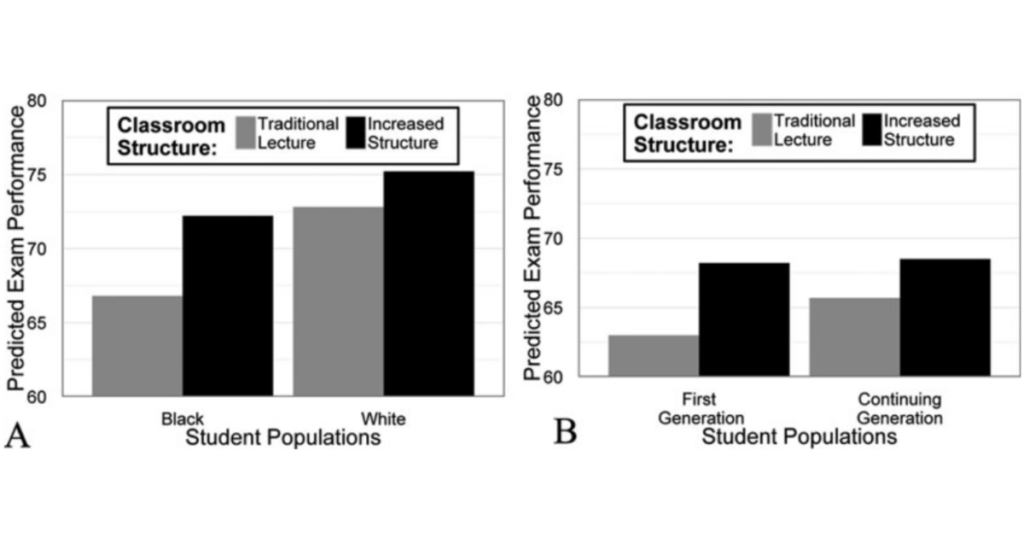
Andrew Powell
Learn to Win CEO & Co-Founder
Do you remember how you first learned to ride a bike?
Let me guess. First, you read the manufacturer’s manual, cover-to-cover. You paid close attention to the name of each component.
Then, you watched a video lecture on the principles of balance, with lots of helpful slides.
Finally, you proved your mastery… by completing a 10-question multiple-choice quiz.
How’d I do?
Of course I’m joking. If you had tried to learn this way, you probably would have crashed your bike on the way home!
We learn best by doing. In the same way that reading a cookbook won’t transform you into a great chef overnight, reading about cycling won’t teach you to ride a bike.
Learning takes hands-on practice and the occasional wipeout (ideally, somewhere where you can land softly, while wearing a helmet!). With every practice cycle, you get better, until what once seemed unreachable becomes second-nature.
This is the essence of active learning. It’s an approach that emphasizes learning by doing, with hands-on practice, plenty of feedback, and a safe environment to learn from mistakes.
At Learn to Win, we’re passionate advocates of active learning. When companies incorporate active learning into training, employees get better at their jobs faster than anywhere else. And there’s a mountain of published evidence that proves why.
In this piece, I’ll cover:
- The definition of “active learning,” and how it differs from passive learning.
- My personal experience with active learning, and how that inspired me to found Learn to Win.
- Definitive proof that active learning is dramatically more effective than alternative approaches.
- Tactical tips for how you can incorporate active learning into your training today (even if you don’t yet use Learn to Win).
What’s the difference between active learning and passive learning?
Let’s start with a quick definition of terms, since I’ll refer to both active learning and passive learning frequently in this article.
Passive learning: Teaching by telling
We’ve all been on the receiving end of passive learning. Think back to your school days. Any time you found yourself sitting through a lecture, taking notes, or skimming a textbook, you were experiencing passive learning. How much of it stuck?
Those classroom days may be behind you, but you’ll find passive learning everywhere you look in workplace training. It lurks in endless PowerPoint presentations, dry manuals, and uninspiring training videos.
Think back to your last bout with passive learning. How much do you remember of what you learned? Did you leave it feeling ready to do your job?
Active learning: Learning by doing
In contrast, active learning prioritizes participation, problem-solving, and critical thinking. No one expects learners to sit there and absorb information. Instead, learners grapple with the material through practice, group activities, discussions, and hands-on projects.
When learners engage actively in the learning process, they practice applying knowledge in real-world scenarios. As a result, they retain much more and, ultimately, develop skills that endure.
Said another way: Passive learning focuses the spotlight on the instructor delivering the training. On the other hand, active learning is all about the learner and what they are actually doing to practice the new knowledge or skill.
How active learning inspired me to create Learn to Win
The first inspiration for Learn to Win grew out of a conversation in a crowded lecture hall over a decade ago.
At the time, I was one of hundreds of students enrolled in Econ 101 at the University of North Carolina at Chapel Hill. The course was required for a number of majors at UNC, and it relied on the traditional, lecture-based mode of instruction.
I remember sitting next to a senior who was taking that Econ 101 course for the 5th time. She had been unable to pass the course in each of her previous 4 attempts. She was the first person in her family to attend college, and she had worked so hard to earn her place at UNC. Passing that Econ 101 class was the only thing standing between her and graduating.
Unfortunately, her predicament wasn’t unique. First-generation students are twice as likely to drop out of college compared to their non-first-generation peers. And 90% of low-income, first-generation college students don’t graduate within 6 years of enrolling in college.
My classmate’s story troubled me. While she described herself as “failing the course,” I could see how hard she was working to graduate. She was failing the course, but was it possible that the course was failing her?
What if the problem was with the course itself? If we could find and embrace a more effective way of teaching, would it be possible for all students to ace the material, graduate, and create better futures for their families?
There had to be a better way. I got to know several forward-thinking professors at UNC who were implementing innovative teaching methods to solve this exact problem. For example, Dr. Kelly Hogan had been experimenting with teaching Bio 101 in a high-structure active learning format and had seen promising results.
I approached my economics professor, Dr. Rita Balaban, with the idea of “flipping the classroom” to incorporate a more active approach. We thought we could improve learning outcomes and passing rates through this methodology.
So we redesigned the class together.
We replaced the long lectures with pre-recorded mini-lectures, focused on a single topic per day.
We built pre-class quizzes, which students completed before class, and then spent class time reviewing the knowledge gaps identified from the quiz.
We focused the majority of class time on actually working problems, either individually or in groups, to give students dramatically more practice reps. As students practiced the material, a cohort of teaching assistants circled the room, ready to offer help if anyone was stuck.
The results were clear: at the end of the course, the student failure rate had been cut in half! On average, student final exam scores improved by 17%.
Encouraged by this success, we worked with the university to scale up this methodology across many more large lecture courses at UNC.
Over the next few years, we saw the active learning model universally benefit students in these courses, and disproportionately benefit first-generation and underrepresented students. The results were so dramatic that The New York Times celebrated the active learning work that had been pioneered at UNC.
Since then, my mission has been to bring the power of active learning beyond the classroom.
The evidence supporting active learning is overwhelming. The utility of the approach extends well beyond the university classroom, and the potential impact of active learning in the workplace is profound.
The Evidence: Proof that active learning is better for all learners
Active learning reduces failure rates by 55%
In 2014, researchers at the University of Washington analyzed the results of over 200 studies that compared active learning to traditional, lecture-based teaching.
The study found that lecture-based approaches, or “teaching by telling” increases learner failure rates by 55%.
To put the magnitude of this finding in context, Scott Freeman, the primary author of the study, noted that if the same experiment had been structured as randomized controlled trials for a medical intervention, the experiment would have been “stopped for benefit” – in other words, the study would have stopped enrolling patients in the control condition because the treatment being tested was so clearly more beneficial.
Imagine the business impact of reducing the failure rate in your organization by 50%. What would be the ROI of that single change?

Active learning nearly doubles learner performance
When it comes to learning, how you teach matters much more than who teaches it.
That’s one of the findings from a groundbreaking 2011 study by Carl Wieman, a Nobel laureate in physics.
The experiment split students into 2 groups. The control group was taught by an experienced faculty member using standard lecture-based practices. And the experimental group was taught by two teaching assistants who used active learning techniques.
The experimental group relied on the active learning principles of deliberate practice and formative assessment – in other words, low-stakes practice that helps you learn. TAs circulated to help answer questions and provide feedback.
At the end of the experiment, both groups took the same exam. The experimental group that used active learning performed almost 2x better than the lecture-based control group (74% vs. 41%).
This is a powerful insight for companies looking to develop their workforce. To improve your team’s performance, you don’t need to hire a Nobel laureate as a trainer (though if you can, go for it!). Instead, you just need to help your team adopt science-backed active learning methods.

Active learning disproportionately benefits underrepresented learners
Active learning improves performance for all learners. But recent studies have shown that in a classroom setting, active learning disproportionately improves performance for historically underrepresented student groups, such as students of color and first-generation college students.
Kelly Hogan and Sarah Eddy studied the impact of active learning in an introductory biology course at the University of North Carolina at Chapel Hill. They compared a ‘moderate structure’ course (active learning) to a traditional lecture course. The structured course included homework questions, graded prep work, and in-class activities.
All students in the structured course saw improvements, but the most profound performance improvements were among underrepresented student groups.
The so-called “achievement gaps” between black and white students were cut in half due to active learning, and the gap between first-generation and continuing-generation students was closed entirely.

Build active learning into your training today
Now that you’ve seen the data, you know that active learning is a faster and better way to teach all learners. But active learning isn’t just a powerful approach for classroom learning – it’s also a game changer for corporate training.
Companies that harness the power of active learning in their training programs gain a significant competitive edge. They’re able to help their teams get better, faster. They ensure their teams aren’t just well-informed but genuinely skilled and prepared to excel in their jobs.
In an era where the pace of work and industry demands are accelerating rapidly, active learning helps employees master critical skills faster and more effectively. It engages employees in the training process and significantly enhances their job performance. The result? Your organization isn’t just training employees—it’s cultivating valuable in-house expertise. And that’s an edge every company needs.
Learn to Win is the ideal way to build active learning into your training. Our software makes it straightforward for any organization to incorporate proven active learning techniques and ensure plenty of hands-on practice. However, even if you aren’t ready to try Learn to Win, here are three ways to make your training more active today.
- Focus on specific knowledge gaps
- Ask, don’t tell
- Give lots of just-in-time feedback
Focus on specific knowledge gaps
Active learning is all about focus. And to do that, we have to acknowledge a hard truth: You can’t focus on everything. At least, not all at once.
It’s one of the most common training pitfalls. Too often, trainers overwhelm learners with a barrage of exhaustive information. For learners, this feels like drinking from a firehose, and they disengage. By the next day, they’ve forgotten most of what they had learned.
To focus your training, you need to prioritize ruthlessly. Ask, “What’s the most important topic that our team members need to master first?” To answer this question, we use data. A 10-minute spot assessment can quickly reveal the topics that nobody understands and help you focus your training resources.
This spot assessment isn’t a mere tactic; it’s a crucial first step in the agile learning cycles our clients implement with Learn to Win. With these insights, you can hone in on a specific area, build mastery, and then use the data to decide the next point of focus. Each learning cycle fuels incremental performance improvements. This focused approach bolsters knowledge retention and gives your team an edge over competitors still stuck in the old paradigm of mass, unfocused learning.
Ask, don’t tell
Instead of telling your team what they need to know, try quizzing them.
The term “quiz” may trigger unpleasant memories from school days. But they’re actually a potent mechanism for aiding long-term retention and making learning more engaging.
Quizzes are powerful because they’re a form of low-stakes practice. They facilitate ‘recall practice,’ a process that bolsters our ability to remember crucial information. Why is recall practice so effective? It’s due to the way human memory works: When we actively retrieve information, we’re more likely to remember it in the long run.
There’s compelling evidence to support this. Studies have demonstrated that time dedicated to recall practice is 5x more productive than time spent reviewing material. Just imagine how such a shift in approach could have transformed those frantic cramming sessions back in school!
How can we apply this in the workplace? Try implementing low-stakes quizzes throughout your training sessions. These should not be daunting or punitive but a chance for learners to engage with the material and gauge their understanding. Learn to Win’s platform offers customizable quizzes that can be woven seamlessly into your training, helping learners to practice recall in a supportive, dynamic environment.
As your team members actively retrieve the information they’ve been learning, they’re not merely consuming knowledge – they’re wrestling with it, owning it, and, most importantly, remembering it. By asking rather than telling, you’re empowering your employees with a deeper understanding and an enhanced ability to apply their knowledge, creating a more effective, more confident team.
Give lots of just-in-time feedback
Instead of waiting until the end of the training to provide feedback, consider giving it when it’s most valuable: in the moment.
We’ve all had experiences where we received feedback weeks after completing a project. By that time, it’s too late to change course. In many cases, we can barely remember the details of the project! This delay in feedback limits its effectiveness.
Timely, or “just-in-time”, feedback operates differently. It’s about providing constructive insights right when learners are engaging with the material. This real-time feedback enhances the learning process significantly.
It’s not just that just-in-time feedback improves performance. Your learners also crave it. A recent study found that 63% of employees say they want more feedback.
How can we apply this in the workplace? Start by integrating feedback into your training sessions. You can use a platform like Learn to Win, which gives learners real-time feedback. Instead of waiting till the end of a session or module, learners receive guidance as they progress, helping them adjust their understanding and approach on-the-fly.
With this method, your team isn’t just absorbing information – they’re actively refining their knowledge and skills. This iterative process of learning, receiving feedback, and adjusting enables them to build stronger mental models and perform more effectively. By offering timely feedback, you’re supporting your team in becoming not just knowledgeable, but agile and adaptive learners. And that’s a competitive advantage.
Want to learn more?
By now, I hope it’s clear why we at Learn to Win are so passionate about active learning. The data speaks for itself, and we’ve seen how quickly it can transform team performance.
We’re certain that it’s the best way for companies to get better, faster. It’s not just about getting more value out of precious training time. It’s about giving your company an edge in an increasingly competitive market.
If you’re curious about how active learning can accelerate your own organization’s training, we’d love to talk! Click here to set up time with one of our team members.

